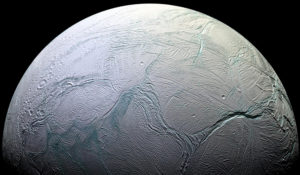Jun 28 2018
Complex Organic Molecules on Enceladus
 Enceladus is one of the most interesting worlds in our solar system. It is a moon of Saturn with a surface comprised entirely of bright ice. Why is the ice so reflective? Because it is constantly replenished from a subsurface ocean of salt water, which gushes through cracks in the surface as geysers.
Enceladus is one of the most interesting worlds in our solar system. It is a moon of Saturn with a surface comprised entirely of bright ice. Why is the ice so reflective? Because it is constantly replenished from a subsurface ocean of salt water, which gushes through cracks in the surface as geysers.
That is intriguing enough, but the implications are even more interesting – most significantly, there is liquid water beneath the frozen surface of Enceladus. Liquid water means a couple of things. First, it means the core of Enceladus is warm. The moon is not frozen solid through. A moon that size should have frozen solid by now, so there must be some source of energy keeping it warm.
The first thought was that tidal forces from Saturn were responsible, but scientists could not make computer models fit. However, a 2017 paper hypothesized that the core of Enceladus may be porous, and this model works. The core flexes, grinding rocks together, creating heat through friction. Further, liquid water would seep into the porous rock, heat to near boiling (90 C) and then rise to the surface and gush out through cracks. Heating would be greatest at the poles, and this is therefore also where the ice is thinnest. The model fits our observations.
Further, ice spewing from Enceladus appears to be responsible for Saturn’s E ring. The Cassini probe gave us a close-up view of the E ring, and according to JPL:
The E ring is mostly made of ice droplets, but among them are peculiar nanoparticles. Cassini detected these passing silica nanograins, which can only be generated where liquid water and rock interact at temperatures above 90 degrees Celsius (about 200 degrees F). This points to hydrothermal vents deep beneath Enceladus’ icy shell, not unlike the hydrothermal vents that dot the ocean floor here on Earth.
That fits the new model too. All of this has astronomers interested in finding the signs of life outside of Earth very excited. Enceladus has a subsurface ocean of warm salty water. Sure, in some parts it’s really warm, but in others, farther from the pole, it may be just right.
Cassini found more than silica nanograins in the geysers of Enceladus and E ring of Saturn – it found simple organic molecules. In this context “organic” simply means containing carbon. Organic molecules, of course, are the basis for life, getting scientists even more excited. So we have water, heat, minerals, and organic molecules. It’s looking pretty good for critters crawling around beneath the surface of Enceladus.
The new update to this exciting story is this:
Using mass spectrometry data from NASA’s Cassini spacecraft, scientists found that large, carbon-rich organic molecules are ejected from cracks in the icy surface of Saturn’s moon Enceladus. Southwest Research Institute scientists think chemical reactions between the moon’s rocky core and warm water from its subsurface ocean are linked to these complex molecules.
“Now we’ve found organic molecules with masses above 200 atomic mass units. That’s over ten times heavier than methane. With complex organic molecules emanating from its liquid water ocean, this moon is the only body besides Earth known to simultaneously satisfy all of the basic requirements for life as we know it.”
So there is basically a “primordial soup” (as Sagan called it) beneath the surface of Enceladus. This makes Enceladus the best candidate we have for life beyond the Earth, possibly an evolutionarily completely different tree of life. Obtaining samples of this potential life to discover if it exists, and for study, should be a high priority. This is one of the biggest scientific questions we face.
It’s possible that Enceladus is missing some ingredient necessary for life to get started. Perhaps all the water is eventually cooked to too high a temperature for life to survive. But there are extremophiles on Earth that can survive high temperatures. And the existence of large complex organic molecules means that they can survive, which tells us something.
All we can say at this point is that the possibility of life on Enceladus is looking better and better.
I also have to point out that Enceladus is not the only place in our solar system with conditions that can possibly harbor life. The other promising location is Europa, a large moon of Jupiter. Europa is very similar, with a surface of ice and a subsurface ocean of liquid water. Water is also venting to the surface through cracks, and so also has a core that is geologically active.
Europa, even though it is a little smaller than our Moon, has about twice as much water as the Earth. That is a huge ocean.
We don’t have as much information about the contents of that water as we do for Enceladus, because it is not spraying out into a ring we can examine. But it’s probably similar. There is also the rusty brow stains on the surface of Europa, coming from something in the water, but we don’t know what this is. But clearly there is chemistry happening in the warm salty water of Europa.
Europa would be more tricky to examine, because we would likely have to drill through 19-25 km of ice. On Enceladus, the water is coming to us, so we could theoretically just put a probe in orbit and scoop up water from the next geyser.
In any case, both worlds are fascinating and worth some dedicated missions to answer one of the greatest scientific questions of our time – is there life elsewhere in the universe?






